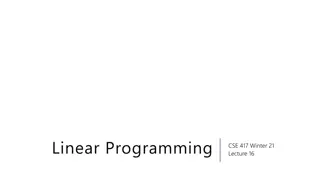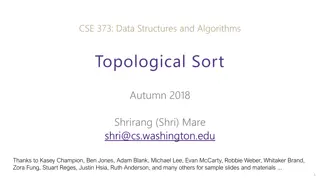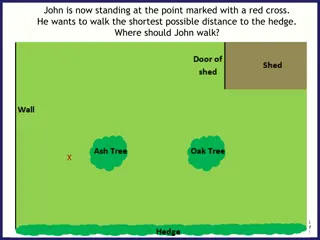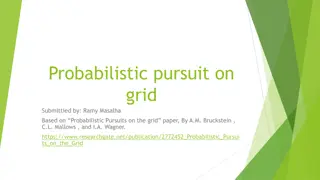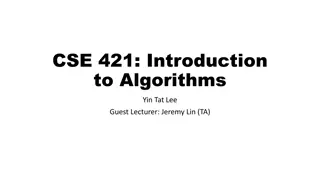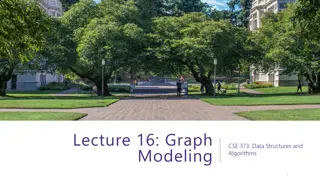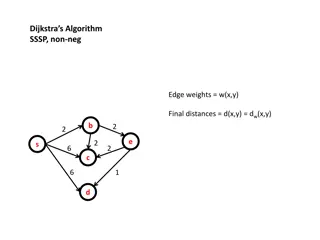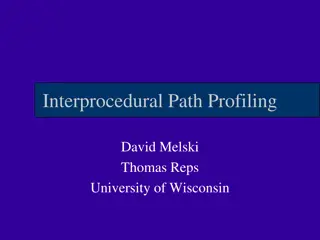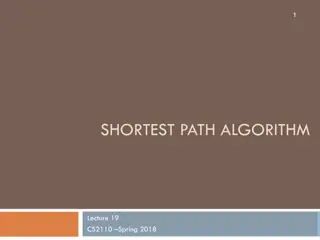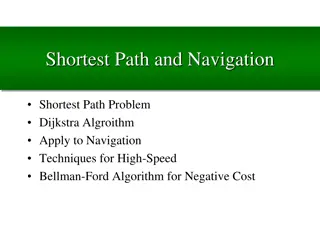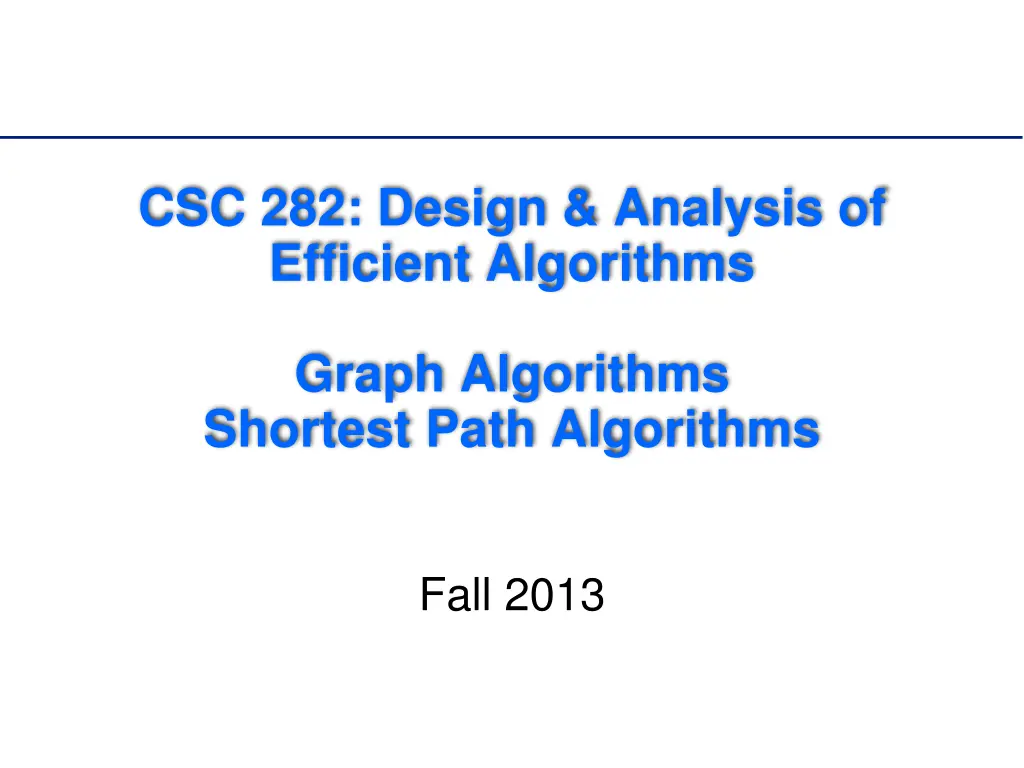
Efficient Graph Algorithms and Path Finding in Computer Science
Explore the realm of efficient graph algorithms and path finding techniques in computer science, covering topics such as shortest path algorithms, iterative depth-first and breadth-first search, and their applications in robot planning and more. Dive into examples of path finding procedures and understand the differences between DFS and BFS for finding shortest paths in graphs.
Download Presentation

Please find below an Image/Link to download the presentation.
The content on the website is provided AS IS for your information and personal use only. It may not be sold, licensed, or shared on other websites without obtaining consent from the author. If you encounter any issues during the download, it is possible that the publisher has removed the file from their server.
You are allowed to download the files provided on this website for personal or commercial use, subject to the condition that they are used lawfully. All files are the property of their respective owners.
The content on the website is provided AS IS for your information and personal use only. It may not be sold, licensed, or shared on other websites without obtaining consent from the author.
E N D
Presentation Transcript
CSC 282: Design & Analysis of Efficient Algorithms Graph Algorithms Shortest Path Algorithms Fall 2013
Path Finding Problems Many problems in computer science correspond to searching for paths in a graph from a given start node Route planning Packet-switching VLSI layout 6-degrees of Kevin Bacon Program synthesis Speech recognition
Application: Robot Planning A huge graph may be implicitly specified by rules for generating it on-the-fly Blocks world: vertex = relative positions of all blocks edge = robot arm stacks one block stack(blue,table) stack(green,blue) stack(blue,red) stack(green,red) stack(green,blue)
Iterative Depth-First Search Path Finding procedure DFS_Path(G, s) stack: open for each u in V: u.visited = false open.push(s) while not open.empty(): u = open.pop() for each (u,v) in E: if not v.visited then v.prev = u open.push(v) end
Iterative Breadth-First Search Path Finding procedure BFS_Path(G, s) queue: open for each u in V: u.visited = false open.enqueue(s) while not open.empty(): u = open.dequeue() for each (u,v) in E: if not v.visited then v.prev = u open.enqueue(v) end
Example DFS Path Finding Rochester Seattle Salt Lake City San Francisco Dallas
Example DFS Path Finding Rochester Seattle Salt Lake City San Francisco Dallas
Example DFS Path Finding Rochester Seattle Salt Lake City San Francisco Dallas
DFS BFS O(|G|) Shortest paths? O(|G|) Shortest paths?
DFS BFS O(|G|) Shortest paths? NO O(|G|) Shortest paths? YES
Lengths on Edges Path length: the number of edges in the path Path cost: the sum of the costs of each edge Chicago 3.5 Seattle 2 2 Salt Lake City 2 2.5 2.5 2.5 3 San Francisco Dallas
Edsger Wybe Dijkstra (1930-2002) Invented concepts of structured programming, synchronization, weakest precondition, and "semaphores" for controlling computer processes. The Oxford English Dictionary cites his use of the words "vector" and "stack" in a computing context. Believed programming should be taught without computers 1972 Turing Award In their capacity as a tool, computers will be but a ripple on the surface of our culture. In their capacity as intellectual challenge, they are without precedent in the cultural history of mankind.
Dijkstras Algorithm for Single Source Shortest Path Similar to breadth-first search, but uses a heap instead of a queue: Always select (expand) the vertex that has a lowest-cost path to the start vertex Correctly handles the case where the shortest path to a vertex is not the one with fewest edges
Dijkstras Algorithm procedure Dijkstra(G, s) heap: open for each u in V: u.dist = infinity s.dist = 0 for each u in V: open.insert(u, u.dist) while not open.empty(): u = open.deleteMin() for each (u,v) in E: if v.dist > u.dist + length(u,v) then v.dist = u.dist + length(u,v) v.prev = u open.decreaseKey(v) end
Demo http://www.unf.edu/~wkloster/foundati ons/DijkstraApplet/DijkstraApplet.htm
Analyzing Dijkstras Algorithm To create the heap, insert each node This happens |V| times Once a vertex is removed from the head, the cost of the shortest path to that node is known This happens |V| times While a vertex is still in the heap, another shorter path to it might still be found This happens at most |E| times
Run Time Analysis |V|O(insert) + |V|O(delete) + |E|O(decreaseKey) Binary heap: |V|O(log|V|) + |V|O(log|V|) + |E|O(log|V|) = O((|V|+|E|) log|V|) Array: |V|O(1) + |V|O(|V|) + |E|O(1) = O(|V|2)
Finding Paths in Very Large Graphs It is expensive to find optimal paths in large graphs using BFS or Dijkstra s algorithm If we only care about paths to a goal node, when should we stop? If the graph is generated on the fly as it is searched, how do we avoid needing to generate all nodes when initializing the heap?
Dijkstras Algorithm with Goal procedure Dijkstra(G, s, g) heap: open s.dist = 0 open.insert(s, s.dist) while not open.empty(): u = open.deleteMin() if u = g then return for each (u,v) in E: // might create v if v is newly created then v.dist = infinity if v.dist > u.dist + length(u,v) then v.dist = u.dist + length(u,v) v.prev = u if open.contains(v) then open.decreaseKey(v, v.dist) else open.insert(v, v.dist) end
Finding Paths in Very Large Graphs It is expensive to find optimal paths in large graphs using BFS or Dijkstra s algorithm If we only care about paths to a goal node, when should we stop? If the graph is generated on the fly as it is searched, how do we avoid needing to generate all nodes when initializing the heap? How can we use search heuristics?
Best-First Search The Manhattan distance is an estimate of the distance to the goal It is a search heuristic It is optimistic (never overestimates) Best-First Search Order nodes in priority to minimize estimated distance to the goal Compare: BFS / Dijkstra Order nodes in priority to minimize distance from the start
Example 53nd St 52nd St G 51st St S 50th St 10th Ave 9th Ave 8th Ave 2nd Ave 3rd Ave 7th Ave 6th Ave 5th Ave 4th Ave Plan a route from 9th & 50th to 3rd & 51st
Example 53nd St 52nd St G 51st St S 50th St 10th Ave 9th Ave 8th Ave 2nd Ave 3rd Ave 7th Ave 6th Ave 5th Ave 4th Ave Plan a route from 9th & 50th to 3rd & 51st
Best First Search procedure best_first(G, s, g) heap: open open.insert(s, heuristic(s,g)) while not open.empty(): u = open.deleteMin() u.visited = true if u = g then return for each (u,v) in E: if v is newly created then v.visited = false if not v.visited then v.prev = u open.insert(v, heuristic(v,g)) end
Non-Optimality of Best-First Path found by Best-first 53nd St 52nd St S G 51st St 50th St 10th Ave 9th Ave 8th Ave 2nd Ave 3rd Ave 7th Ave 6th Ave 5th Ave 4th Ave Shortest Path
Improving Best-First Best-first is often tremendously faster than BFS/Dijkstra, but might stop with a non-optimal solution How can it be modified to be (almost) as fast, but guaranteed to find optimal solutions? A* - Hart, Nilsson, Raphael 1968 One of the first significant algorithms developed in AI Widely used in many applications
A* Exactly like Best-first search, but using a different criteria for the priority queue: minimize (distance from start) + (estimated distance to goal) priority f(n) = g(n) + h(n) f(n) = priority of a node g(n) = true distance from start h(n) = heuristic distance to goal
A* procedure aStar(G, s, g) heap: open s.dist = 0 open.insert(s, s.dist+heuristic(s,g)) while not open.empty(): u = open.deleteMin() if u = g then return for each (u,v) in E: if v is newly created then v.dist = infinity if v.dist > u.dist + length(u,v) then v.dist = u.dist + length(u,v) v.prev = u if open.contains(v) then open.decreaseKey(v, v.dist+heuristic(v,g)) else open.insert(v, v.dist+heuristic(v,g)) end
A* in Action h=7+3 h=6+2 53nd St 52nd St S G 51st St 50th St 10th Ave 9th Ave 8th Ave 2nd Ave 3rd Ave 7th Ave 6th Ave 5th Ave 4th Ave H=1+7
Applications of A*: Planning A huge graph may be implicitly specified by rules for generating it on-the-fly Blocks world: vertex = relative positions of all blocks edge = robot arm stacks one block stack(blue,table) stack(green,blue) stack(blue,red) stack(green,red) stack(green,blue)
Blocks World Blocks world: distance = number of stacks to perform heuristic lower bound = number of blocks out of place (on wrong thing) # out of place = 1, true distance to goal = 3
Demo http://www.cs.rochester.edu/u/kautz/M azesOriginal/search_algorithm_demo .htm
Negative Lengths on Edges Suppose we allow negative lengths on edges? Dijkstra: Can fail to find shortest path A*: Can fail to terminate if there is a negative cycle
Bellman-Ford procedure BellmanFord(G, s) for each u in V: u.dist = infinity s.dist = 0 repeat |V|-1 times: for each (u,v) in E: if v.dist > u.dist + length(u,v) then v.dist = u.dist + length(u,v) v.prev = u end Run time:
Bellman-Ford procedure aStar(G, s) for each u in V: u.dist = infinity s.dist = 0 repeat |V|-1 times: for each (u,v) in E: if v.dist > u.dist + length(u,v) then v.dist = u.dist + length(u,v) v.prev = u end Run time: O(|V||E|)
Summary: Graph Search Depth First Little memory required Might find non-optimal path Breadth First Much memory required Always finds optimal path Dijskstra s Short Path Algorithm Like BFS for weighted graphs Best First Can visit fewer nodes Might find non-optimal path A* Can visit fewer nodes than BFS or Dijkstra Optimal if heuristic has certain common properties Bellman-Ford Handles negative edges Not as efficient as Dijsktra for positive only graphs

